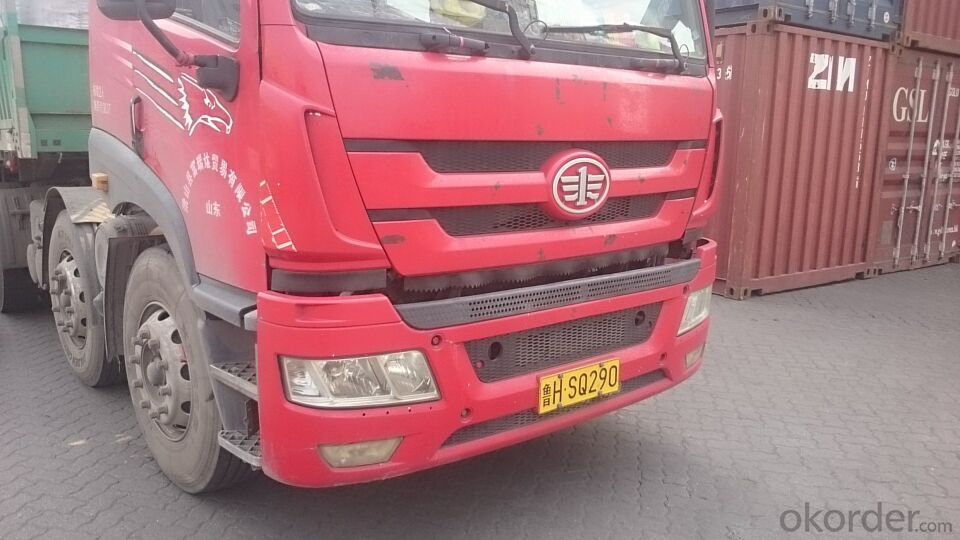Used in EAF as Charge Coke for Steel Mills with Mositure 0.5%max
- Loading Port:
- Tianjin
- Payment Terms:
- TT OR LC
- Min Order Qty:
- 21 m.t.
- Supply Capability:
- 6000 m.t./month
OKorder Service Pledge
OKorder Financial Service
You Might Also Like
Introduction:
Calcined anthracite can be called carbon additive, carbon raiser, recarburizer, injection coke, charging coke, gas calcined anthracite.
Carbon Additive/Calcined Anthracite Coal may substitute massively refinery coke or graphite. Meanwhile its cost is much less than the refinery coke and graphite. Carbon Additive is mainly used in electric steel ovens, water filtering, rust removal in shipbuilding and production of carbon material.
It has good characteristics with low ash, low resistivity, low sulphur, high carbon and high density. It is the best material for high quality carbon products. It is used as carbon additive in steel industry or fuel.
Features:
Best quality Taixi anthracite as raw materials through high temperature calcined at 800-1200 ℃ by the DC electric calciner with results in eliminating the moisture and volatile matter from Anthracite efficiently, improving the density and the electric conductivity and strengthening the mechanical strength and anti-oxidation, It has good characteristics with low ash, low resistivity, low carbon and high density. It is the best material for high quality carbon products, it is used as carbon additive in steel industry or fuel.
Specifications:
F.C.% | 95MIN | 94MIN | 93MIN | 92MIN | 90MIN | 85MIN | 84MIN |
ASH % | 4MAX | 5MAX | 6 MAX | 6.5MAX | 8.5MAX | 12MAX | 13MAX |
V.M.% | 1 MAX | 1MAX | 1.0MAX | 1.5MAX | 1.5MAX | 3 MAX | 3 MAX |
SULFUR % | 0.3MAX | 0.3MAX | 0.3MAX | 0.35MAX | 0.35MAX | 0.5MAX | 0.5MAX |
MOISTURE % | 0.5MAX | 0.5MAX | 0.5MAX | 0.5MAX | 0.5MAX | 1MAX | 1MAX |
Pictures




FAQ:
Packing:
(1). Waterproof jumbo bags: 800kgs~1100kgs/ bag according to different grain sizes;
(2). Waterproof PP woven bags / Paper bags: 5kg / 7.5kg / 12.5kg / 20kg / 25kg / 30kg / 50kg small bags;
(3). Small bags into jumbo bags: waterproof PP woven bags / paper bags in 800kg ~1100kg jumbo bags.
Payment terms
20% down payment and 80% against copy of B/L.
Workable LC at sight,
- Q: Intend to go to the barbecue and 35 friends over the weekend, but because it is new, so I don't know how to put the carbon burning, found some web sites are also a few pens, see me confused......Hope which experienced friend to help enlighten me, the best to the specific point, thank you ah!
- A few days ago I just go to the barbecue, barbecue in the general store to buy carbon (long, with a hole in the middle of smokeless carbon) is not easy, but is cheaper, you can buy some flammable carbon on the Internet, and then get a little pure alcohol ignition when the flammable carbon below, ordinary carbon. Add a little alcohol, a little on the. It takes about 20 minutes to barbecue! Wish you have a good time.
- Q: How does carbon affect the stability of ecosystems?
- Carbon plays a crucial role in the stability of ecosystems as it is a key component of all living organisms. It affects stability primarily through the carbon cycle, where it is exchanged between the atmosphere, plants, animals, and soil. Carbon dioxide, a greenhouse gas, regulates the Earth's temperature and climate. Excessive carbon emissions from human activities, such as burning fossil fuels, contribute to climate change, which disrupts ecosystems and poses risks to biodiversity, water resources, and food production. Additionally, carbon is essential for photosynthesis, the process by which plants convert CO2 into oxygen and organic compounds, supporting the entire food chain. Hence, its availability and balance are essential for maintaining the stability and functioning of ecosystems.
- Q: What are the different types of carbon-based inks?
- There are various types of carbon-based inks, including carbon black ink, graphite ink, and carbon nanotube ink.
- Q: What are the impacts of carbon emissions on natural disasters?
- Carbon emissions contribute to the intensification and frequency of natural disasters. The release of greenhouse gases, such as carbon dioxide, traps heat in the atmosphere, leading to global warming and climate change. This warmer climate alters weather patterns, resulting in more frequent and severe events like hurricanes, droughts, wildfires, and floods. Additionally, the melting of polar ice caps due to increased temperatures raises sea levels, making coastal regions more vulnerable to storm surges and causing further devastation. Overall, carbon emissions exacerbate the impact of natural disasters, posing significant threats to human lives, ecosystems, and economies.
- Q: Excuse me, carbon steel, carbon steel pipe, seamless steel pipe, spiral steel pipe, what is the difference?
- There is no joint in the whole. The material can be used according to the needs, often used for high temperature, high pressure and other fluids. Hence, it is called seamless steel tube. The spiral steel tube is also formed by the heating and rotating of the strip steel. The utility model is suitable for the fluid below 30Kg, and the material can replace the seamless pipe with the big caliber and difficult to be manufactured according to the requirement, and is suitable for the medium and low pressure fluid with large caliber.
- Q: Why use carbon batteries for alarm clocks?
- Look at your clock is what kind of, some nickel battery (batteries) can also be a bit expensive. Lithium battery. And what in fact almost never mind, as long as you start voltage alarm on the line. You said carbon battery is called alkaline battery his standard voltage is 1.5V the charging the battery is generally 1.2V. to this problem is not a reward.
- Q: What are the effects of carbon emissions on the stability of wetlands?
- Carbon emissions have significant effects on the stability of wetlands. Increased carbon emissions contribute to global warming, causing rising temperatures and altered precipitation patterns, which in turn lead to changes in the hydrological cycle. These changes impact the water balance and distribution within wetland ecosystems, potentially resulting in increased drying and loss of water-dependent vegetation. Additionally, carbon emissions can lead to increased acidity in wetland waters, which can harm aquatic life and disrupt the delicate balance of the ecosystem. Overall, carbon emissions pose a significant threat to wetlands, jeopardizing their stability and the many benefits they provide, such as water filtration, carbon sequestration, and habitat for diverse plant and animal species.
- Q: What's the difference between coal and carbon?
- Coal is the main component of carbon, carbon in addition to coal, as well as graphite, diamonds and so on
- Q: What are the impacts of carbon emissions on the stability of grasslands?
- Carbon emissions can have significant impacts on the stability of grasslands. Increased levels of carbon in the atmosphere contribute to global warming, which in turn leads to changes in precipitation patterns and higher temperatures. These changes can result in drought conditions and increased frequency and intensity of wildfires, both of which can destabilize grasslands. Additionally, elevated carbon dioxide levels can promote the growth of invasive plant species, which can outcompete native grasses and disrupt the balance of grassland ecosystems. Overall, carbon emissions pose a threat to the stability and biodiversity of grasslands.
- Q: How does carbon affect the formation of blizzards?
- Carbon does not directly affect the formation of blizzards. Blizzards are intense winter storms characterized by strong winds, low temperatures, and heavy snowfall. They typically occur when a low-pressure system moves into an area with sufficient moisture and cold air. The primary factors that influence the formation of blizzards are temperature, moisture, and wind patterns. However, carbon emissions and their impact on the climate can indirectly influence the frequency and intensity of blizzards. Carbon dioxide (CO2) and other greenhouse gases trap heat in the atmosphere, leading to global warming. This warming effect can alter weather patterns, including the conditions necessary for blizzard formation. Warmer temperatures caused by carbon emissions can lead to changes in precipitation patterns, including increased moisture content in the atmosphere. This additional moisture, combined with the cold air necessary for blizzards, can contribute to heavier snowfall during these storms. Furthermore, climate change can affect wind patterns, which can impact the intensity and duration of blizzards. Changes in atmospheric circulation patterns can alter the tracks and strength of storms, potentially leading to more or less frequent blizzard events in certain regions. It is important to note that the specific impact of carbon emissions on blizzard formation varies depending on regional and local factors. The complex nature of weather systems and the interaction between different variables make it challenging to attribute any single weather event solely to carbon emissions. However, the overall influence of carbon emissions on the climate system increases the potential for more extreme weather events, including blizzards.
Send your message to us
Used in EAF as Charge Coke for Steel Mills with Mositure 0.5%max
- Loading Port:
- Tianjin
- Payment Terms:
- TT OR LC
- Min Order Qty:
- 21 m.t.
- Supply Capability:
- 6000 m.t./month
OKorder Service Pledge
OKorder Financial Service
Similar products
Hot products
Hot Searches


























